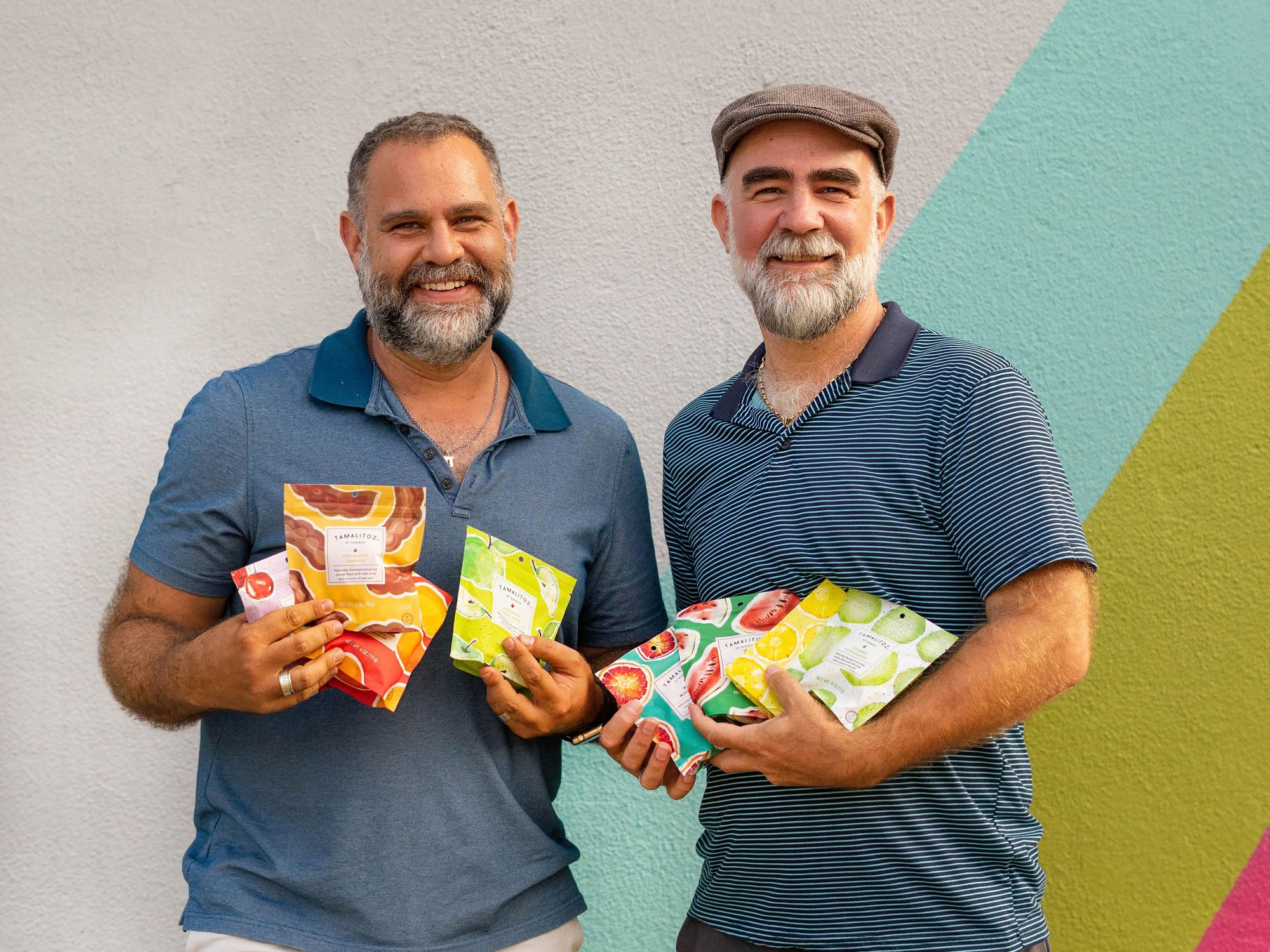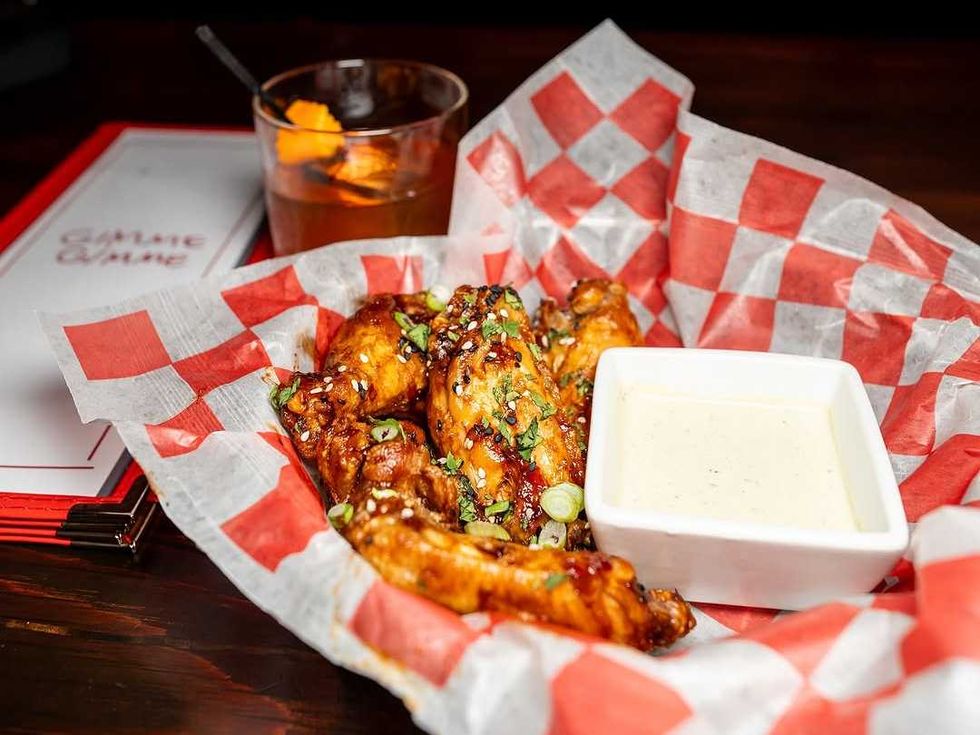A Sweeter Deal
How a Mexican candy brand used San Antonio as a gateway to the U.S.

Husbands and Tamalitoz owners Jack and Dec had meetings with H-E-B days after finishing packaging.
For inhabitants of a country with a dizzying variety of candy, Americans are not very familiar with handmade confectionery. Enter the candy pullers of Instagram, who make mesmerizing, widely viewed content folding, rolling out, and chopping little pieces of hard candy most of us have never tasted. Enter the Mexican-American brand Tamalitoz.
These little “pillows,” as candy maker and founder Jack Bessudo calls them, are made in a similar way to candy canes. Hard candy is placed on a puller (like the saltwater taffy machines of the Northeast), which incorporates some air into the sugar mixture. It’s rolled out into logs, and stretched into thinner canes, which then go through a roller pinching them into little pillow shapes, like ravioli.
“I learned how to make candy from a guy that worked in this candy shop in Australia,” says Bessudo. “So I had actually seen that candy shop on a business trip, like, 20 years ago, and I fell in love with the concept of that store.”
The European technique produces what many think of as old-fashioned candies, but Tamalitoz are kicked up a notch with traditional Mexican flavors for an exciting fusion: no matter the flavor of the candy itself — things like watermelon, mango, tamarind, and cucumber — each pillow is filled with chili, lime, and sea salt. The hard candy forms a shell around the outside, and the aerated inside dissolves, similar to malt powder.
In August, Tamalitoz added a softer, low-sugar candy to the lineup — like a vegan Starburst sweetened with monk fruit — called ChewLows. This October, the brand also expects to release a new collaboration with Nadia Elhaj of Cornucopia, a popcorn maker in Tamalitoz's new home, Austin. Both expansions stay on-brand with fruity flavors and a spicy kick.
Tamalitoz were best-sellers at Bessudo’s several shops in Mexico, Sugarox, where visitors loved watching the process. His English boyfriend, Dec — who would become his husband — helped around the shop in its early stages, handling the more serious business while Jack experimented with sugar.
Thankfully, Tamalitoz were also easy to make, so they were the flagship product when the couple decided it was time to expand. The Sugarox owners both loved Mexico, but the language barrier was hard for Dec, who suggested moving the business to the United States, where Jack had grown up, in Houston.
Rather than suffer through the minutia of international candy exporting alone, Bessudo made some friends. Serving as a board member for the American Society of Mexico, he met City of San Antonio representative Jill Metcalfe, who in turn connected him with the Free Trade Alliance. Things moved fast.
“They helped us with looking at the business plan and the opportunities, and they were a really great bunch of people,” says Bessudo. “After we did all of that … they offer to set up meetings with potential buyers. The first people that ever saw the finished product was two days after we had done [the packaging]. And one of the meetings that we had was with the procurement person at H-E-B.”
Still a small team hand-making candy at every step, Sugarox stretched itself thin to make 9,000 bags per month, falling far short of H-E-B’s goal of 60,000. The Texas retailer said it’d wait. Meanwhile, a Walmart buyer at a convention put Tamalitoz on shelves as Sugarox worked to up its production, learning the hard way that making thousands of bags of candy is not the same quaint experience as running some stores on charm and taste.
“One of my concerns was, how are people going to react to a high-end Mexican style candy?” says Bessudo. “Living in San Antonio, Mexican candy is not considered premium. It's delicious, but it's not premium. Especially with the pricing strategy … to our surprise, people were extremely accepting of it.”
At the same convention, they met another shop owner who explained her candy making process at a facility in Tijuana, Mexico. The new allies created a new supply chain from Tijuana to San Diego to Austin, where the couple moved, and started delivering small shipments to local H-E-Bs. They passed the 20-store milestone, shifted to UPS shipments, and started the expansions that led to chews and popcorn.
Like many pandemic businesses going through growing pains, Sugarox had to cut back somewhere, and the pair decided to close all their Mexican stores. Thus far, though, Tamalitoz have crossed every invisible line, from Mexico to San Antonio; as a gay couple looking for support in corporate retail; and as artisans hoping to show Americans how high their candy standards can be. Mexico has not tasted its last Tamalitoz.
Tamalitoz can be found at H-E-B, Walmart, and independent retailers mapped at tamalitoz.com. A new popcorn product is coming soon.

 Gimme Gimme's bar food is as good as its cocktails.Gimme Gimme/ Instagram
Gimme Gimme's bar food is as good as its cocktails.Gimme Gimme/ Instagram Stop by Jue Let after a day or Pearl shopping.Photo courtesy of Jue Let.
Stop by Jue Let after a day or Pearl shopping.Photo courtesy of Jue Let.